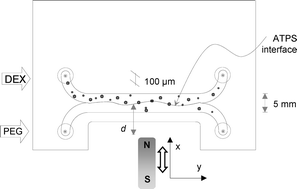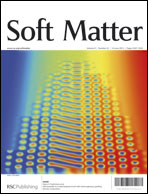Particle dynamics and separation at liquid–liquid interfaces
Abstract
Experiments with magnetic microspheres crossing the interface between two immiscible liquids under the influence of a magnetic field are reported. The liquids form a bilaminated configuration in a microchannel close to which a permanent magnet is arranged. After having approached the interface, the particles “snap in”, indicating the presence of a three-phase contact line. Subsequently, the particles are drawn into the second phase, during which they deform the liquid–liquid interface and finally detach from it. The dependence of this process on the size of the microspheres is studied, showing that via transfer across a liquid–liquid interface, a size separation of particles can be achieved. Comparing the results for 1.29 μm diameter particles with those for 4.69 μm diameter particles, it is found that the small particles are able to cross the interface more easily than what is expected from a simple scaling analysis taking into account the balance between magnetic and interfacial forces on the particles. Potential reasons for this unexpected behavior are discussed. The most likely explanation involves the line tension that destabilizes smaller particles adsorbed to a liquid–liquid interface more than larger particles.


 Please wait while we load your content...
Please wait while we load your content...